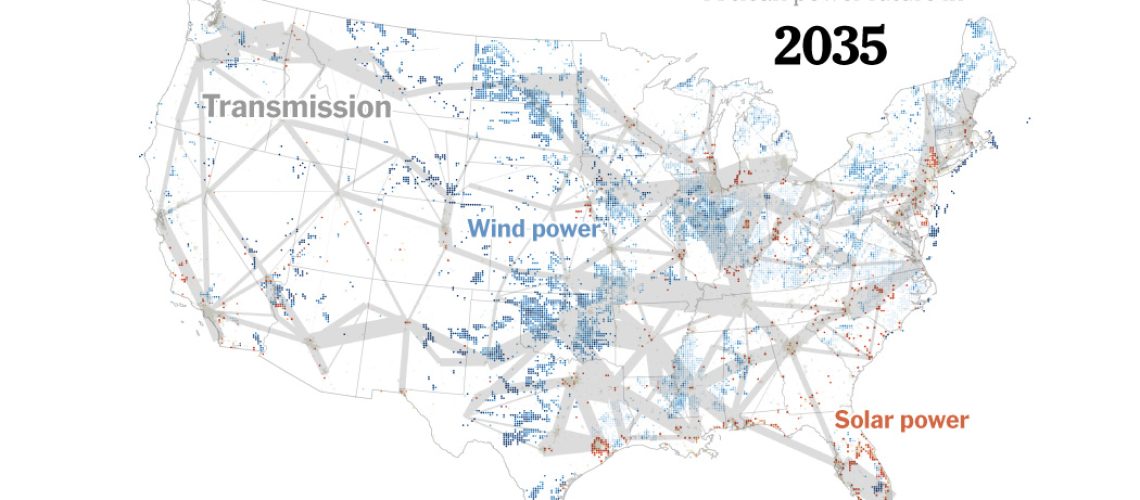The U.S. electric grid is often described as a vast, synchronized machine — a network of wires carrying electricity from power plants across the country into our homes.
But, in reality, there is no single U.S. grid. There are three — one in the West, one in the East and one in Texas — that only connect at a few points and share little power between them.
Those grids are further divided into a patchwork of operators with competing interests. That makes it hard to build the long-distance power lines needed to transport wind and solar nationwide.
America’s fragmented electric grid, which was largely built to accommodate coal and gas plants, is becoming a major obstacle to efforts to fight climate change.
Tapping into the nation’s vast supplies of wind and solar energy would be one of the cheapest ways to cut the emissions that are dangerously heating the planet, studies have found. That would mean building thousands of wind turbines across the gusty Great Plains and acres of solar arrays across the South, creating clean, low-cost electricity to power homes, vehicles and factories.
But many spots with the best sun and wind are far from cities and the existing grid. To make the plan work, the nation would need thousands of miles of new high-voltage transmission lines — large power lines that would span multiple grid regions.
To understand the scale of what’s needed, compare today’s renewable energy and transmission system to one estimate of what it would take to reach the Biden administration’s goal of 100 percent clean electricity generation by 2035. Transmission capacity would need to more than double in just over a decade:
Source: National Renewable Energy Laboratory | The 2035 map is based on the “All Options” path from NREL’s 100% Clean Electricity by 2035 Study. Both maps show utility-scale renewable projects, but do not include distributed installations, like rooftop solar.
There are enormous challenges to building that much transmission, including convoluted permitting processes and potential opposition from local communities. But the problems start with planning — or rather, a lack of planning.
There is no single entity in charge of organizing the grid, the way the federal government oversaw the development of the Interstate Highway System in the 1950s and ‘60s. The electric system was cobbled together over a century by thousands of independent utilities building smaller-scale grids to carry power from large coal, nuclear or gas plants to nearby customers.
By contrast, the kinds of longer-distance transmission lines that would transport wind and solar from remote rural areas often require the approval of multiple regional authorities, who often disagree over whether the lines are needed or who should pay for them.
“It’s very different from how we do other types of national infrastructure,” said Michael Goggin, vice president at Grid Strategies, a consulting group. “Highways, gas, pipelines — all that is paid for and permitted at the federal level primarily.”
In recent decades, the country has hardly built any major high-voltage power lines that connect different grid regions. While utilities and grid operators now spend roughly $25 billion per year on transmission, much of that consists of local upgrades instead of long-distance lines that could import cheaper, cleaner power from farther away.
“Utilities plan for local needs and build lines without thinking of the bigger picture,” said Christy Walsh, an attorney at the Natural Resources Defense Council.
Study after study has found that broader grid upgrades would be hugely beneficial. A recent draft analysis by the Department of Energy found “a pressing need for additional electric transmission” — especially between different regions.
The climate stakes are high. Last year, Congress approved hundreds of billions of dollars for solar panels, wind turbines, electric vehicles and other technologies to tackle global warming. But if the United States can’t build new transmission at a faster pace, roughly 80 percent of the emissions reductions expected from that bill might not happen, researchers at the Princeton-led REPEAT Project found.
Already, a lack of transmission capacity means that thousands of proposed wind and solar projects are facing multiyear delays and rising costs to connect to the grid. In many parts of the country, existing power lines are often so clogged that they can’t deliver electricity from wind and solar projects to where it is needed most and demand is often met by more expensive fossil fuel plants closer to homes and businesses. This problem, known as congestion, costs the country billions of dollars per year and has been getting worse.
The dearth of long-distance transmission isn’t just a climate problem, said Mathias Einberger, a manager for RMI’s Carbon-Free Electricity Program. It spells trouble for reliability, too.
Many power operators are increasingly struggling to keep the lights on as demand rises and extreme weather events become more frequent and severe. More capacity to transfer power between regions could help, so that if a storm knocked out power plants in one area, its neighbors could send electricity. Texas, for example, could have suffered fewer blackouts during a deadly winter storm in 2021 if its isolated grid had more connections with the Southeast, one analysis found.
There are a few efforts underway to ease the bottlenecks. The Biden administration has billions of dollars to help fund transmission projects, and Congress has given the federal government new authority to override objections from state regulators for certain power lines deemed to be in the national interest.
“There’s no silver bullet,” said Maria Robinson, the director of the Department of Energy’s newly created Grid Deployment Office. “Every transmission project is unique like a fingerprint, facing its own challenges, so we need a large arsenal of tools to try to move things along.”
The Federal Energy Regulatory Commission, an independent agency that regulates interstate transmission of electricity, gas and oil, is exploring ways to encourage grid operators to do more long-term planning and to strengthen ties between regions. Some lawmakers have proposed bills that would give the commission more power to approve the routes of major new lines that pass through multiple states, the way it does with gas pipelines.
But these efforts still face plenty of resistance. Utilities are sometimes wary of long-distance transmission lines that might undercut their local monopolies. Some Republicans in Congress say giving the federal government more authority over transmission would trample on states’ rights. During the debt ceiling debate, Democrats floated a proposal to mandate more connectivity between different grid regions, a provision that was opposed by some utilities and Republicans, and was eventually dropped.
If the country continues to struggle to build long-distance transmission, it might need to opt for more expensive measures to fight climate change instead, a recent study by the National Renewable Energy Laboratory found. That could mean building more advanced nuclear plants or gas plants that capture their emissions, which could in theory be built closer to population centers.
Getting better at managing how and when we use electricity could also relieve some of the pressure on the grid. For example, utilities could provide incentives for people to charge their electric cars and other devices when demand is low or ask them to turn off unnecessary appliances during extreme weather events.
But even that wouldn’t entirely cancel out the need for a lot more transmission.
“The grid is already a critical element of our energy system,” said Matteo Muratori, an analyst at the National Renewable Energy Laboratory. “But it’s going to become the central piece of the future energy system.”




